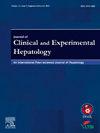Air Leak Syndrome After Percutaneous-endoscopic Rendezvous for Malignant Biliary Obstruction: A Case Report
IF 3.2
Q2 GASTROENTEROLOGY & HEPATOLOGY
Journal of Clinical and Experimental Hepatology
Pub Date : 2025-08-21
DOI:10.1016/j.jceh.2025.103158
引用次数: 0
Abstract
Endoscopic retrograde cholangiopancreatography (ERCP) is a key therapeutic tool for biliary access, but cannulation failure occurs in 5%–10% of cases. We report a 92-year-old woman with obstructive jaundice and complete distal common bile duct obstruction, in whom standard ERCP failed. A percutaneous-endoscopic rendezvous (PE-RV) approach successfully established biliary drainage via a transhepatic guidewire and stent placement. However, the patient developed pneumoperitoneum, tension pneumothorax, and subcutaneous emphysema following abrupt catheter removal. These manifestations are collectively referred to as “air leak syndrome,” which encompasses the abnormal presence of air in the peritoneal cavity, pleural space, and subcutaneous tissue. Imaging showed no pneumoretroperitoneum, suggesting gas migration through an immature percutaneous tract. Urgent drainage and antibiotics led to gradual recovery. This case highlights PE-RV as a valuable salvage technique but underscores the risk of rare gas-related complications when percutaneous tract closure is premature. To minimize the risk of such complications, procedural protocols may need to incorporate delayed catheter removal or tract embolization to ensure safe outcomes. Careful catheter management, delayed removal, and interdisciplinary coordination are essential for safe outcomes.
恶性胆道梗阻经皮-内窥镜联合治疗后漏气综合征1例
内镜逆行胆管造影(ERCP)是胆道通路的关键治疗工具,但插管失败发生率为5%-10%。我们报告一位92岁女性梗阻性黄疸和完全性胆总管远端梗阻,其标准ERCP失败。经皮内镜交会(PE-RV)入路通过经肝导丝和支架置入成功建立胆道引流。然而,在突然拔除导管后,患者出现气腹、紧张性气胸和皮下肺气肿。这些表现统称为“漏气综合征”,包括空气在腹膜腔、胸膜间隙和皮下组织中的异常存在。影像学显示腹膜无气,提示气体通过未成熟的经皮管道迁移。紧急引流和抗生素治疗使患者逐渐恢复。本病例强调PE-RV是一种有价值的抢救技术,但也强调了经皮气管过早闭合时罕见的气体相关并发症的风险。为了将此类并发症的风险降至最低,手术方案可能需要包括延迟拔管或导管栓塞以确保安全结果。谨慎的导管管理,延迟拔除和跨学科协调是安全结果的必要条件。
本文章由计算机程序翻译,如有差异,请以英文原文为准。
求助全文
约1分钟内获得全文
求助全文
来源期刊

Journal of Clinical and Experimental Hepatology
GASTROENTEROLOGY & HEPATOLOGY-
CiteScore
4.90
自引率
16.70%
发文量
537
审稿时长
64 days
 求助内容:
求助内容: 应助结果提醒方式:
应助结果提醒方式:


